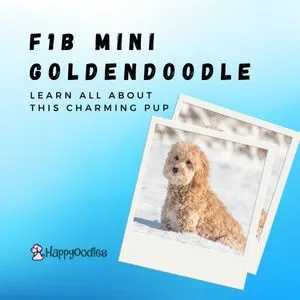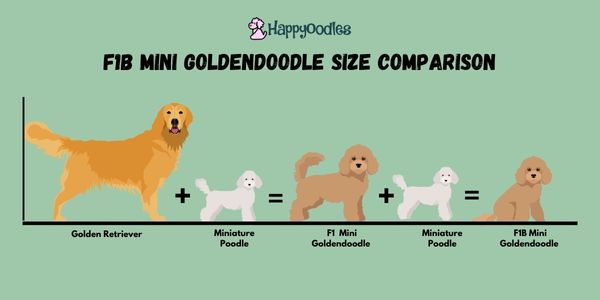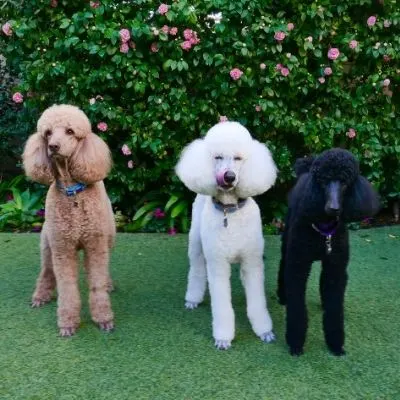Updated: 01/09/2024 – Whether you are looking to get a F1B Mini Goldendoodle or you just want to learn more about them, you are not alone.
The F1B mini along with the full sized F1B Goldendoodle are two of the most sort after types of Goldendoodles today.
But there is a lot of misinformation about this popular pup. Here, we will provide you with the most up to date researched information on the F1B mini Goldendoodle.
In this post we will go over:
- What the F1B mini Goldendoodle is
- How they are breed
- Temperament
- Size when full-grown
- Health concerns
- Best places to look for one
- Cost of a F1b Golden doodle
- Frequently Asked Questions
Let’s get Started!

What is a F1B Mini Goldendoodle?
The F1B Mini Goldendoodle is the result of pairing a mini poodle and a F1 mini Goldendoodle. The “F” denotes the dog’s generation in the breeding process. “F1” indicates the first time a poodle is mated with a Golden Retriever. While F1B indicates that an F1 was bred to an unrelated dog that was one of the original breeds.
Quick Facts About the F1B Mini Goldendoodle
| Mix | F1 Miniature Goldendoodle and Miniature Poodle |
| Height | 14 and 17 inches tall at shoulder |
| Weight | 26 to 35 pounds |
| Life span | 12 and 15 years |
| Traits | Affectionate, playful, goofy, loyal, highly intelligent and easy to train |
| Colors | Cream, apricot and red, black, chocolate (dark brown), silver and gray |
| Groom | Regular grooming is needed, but the mini’s small size will make it easier |
F1B Mini Goldendoodle Breeding
We already outlined how F1b Goldendoodles are bred. In this section we will review the different types of Goldendoodles.
There are actually three types of Golden Retriever/Poodle Mix breeds; the English, the American and the Australian Goldendoodle. The differences between the three affect their build, colors and maybe even health.

English Goldendoodle
The English Goldendoodle is a mix between the English Golden Retriever (aka a European Golden Retriever) which can be cream in color and a white or cream-colored Poodle. This results in a cream or white colored Goldendoodle.
In addition to a lighter color, English Golden Retrievers are bred to be a little shorter and stockier than the American Golden. Their fur is also shorter with more of a wave.
English Golden Retrievers are portrayed as being healthier than the American Golden Retriever, because they have a lower rate of cancer. Though compared to other breeds, the rate of cancer in European Golden Retrievers is still higher.
American Goldendoodle
The American Goldendoodle is a mix between the American Golden Retriever which tends to be red or an apricot color and any colored Poodle. This is the most common variety of Goldendoodle in the states.
Although American Goldendoodles tend to be a shade of red they can also be cream, apricot or any color the poodle comes in. You can even find a black Goldendoodle.
You need to be careful when purchasing an English Goldendoodle. Some unscrupulous breeders may try to pass off a cream colored American Golden as a European Golden.
Australian Goldendoodle
The Australian Goldendoodle is very different from the English and American Goldendoodles.
Instead of crossing a Golden Retriever with a Poodle, Australian Goldendoodles are a mix between an English Goldendoodle and an Australian Labradoodle. The Australian Labradoodle is known to have up to seven different breeds mixed in.

What how big do F1b Mini Goldendoodles get?
According to the Goldendoodle Association of North America breed standard, the mini Goldendoodle should stand between 14 and 17 inches tall at the shoulders and weigh between 26 and 35 pounds.
While these are the desired sizes, the F1b Mini Goldendoodle size is still unpredictable. Ultimately, the size of your full grown F1b miniature Goldendoodle, is determined by the breeding parent’s size, plus any genes that might be passed down from the grandparents. Remember in the case of the F1B one of the grandparents is a Golden Retriever.
Since the genes that affect size can stay dormant for a couple of generations before they show themselves again it is possible to have a F1b Goldendoodle that is outside of the desired range.
F1b Mini Goldendoodle Temperament
The F1B mini Goldendoodle is a friendly, intelligent, fun loving dog that need to be close to their families. Their easy-going attitude makes them ideal for families with kids and other dogs. While they like to be active, they are also affectionate, and love to cuddle when playtime is over.
The down side to these very social pups is that they don’t like to be alone. Too much alone time can result in separation anxiety and destructive behaviors.

F1b Miniature Goldendoodle Exercise Requirements
The F1B mini Goldendoodle is a lively pup that likes to be outside and active. They excel at agility sports and are ready for any adventure that comes their way.
As intelligent dogs, F1b Miniature Goldendoodle will need both mental stimulation and physical activity to keep them happy and out of trouble.
For mental stimulation, daily training sessions that involve games like hide and seek or agility training will do. Plan for a couple of moderate walks or play time in the backyard to meet their exercise requirements.
Remember all dogs are different, you may need to adjust the amount of exercise to meet their needs.
F1b Miniature Goldendoodle Appearance
Breeding a poodle to a F1 Goldendoodle, results in a F1B Goldendoodle that has curly or wavy hair and long facial hair around their eyes and muzzle. Which is what gives the Goldendoodle their teddy bear looks.
The long facial hairs are referred to as furnishing. It is a dominate trait that is carried by the poodle. The only time a Goldendoodle may not carry the genes for furnishing is when a purebred Golden Retriever is used in the second round of breeding instead of the poodle.

F1b Mini Goldendoodle Maintenance
The f1b miniature Goldendoodle will require daily maintenance to keep their curly locks tangle free. Due to the curly coats that second generation doodles tend to inherit, F1b Goldendoodle is prone to matting. When a doodle’s coat mats it causes the fur to pull on their skin, making the pup very uncomfortable.
Your F1b doodle will need to be groomed every six to eight weeks. The price of professional grooming for a small dog can range between $75 to $150 depending on where you live and if their coat is matted.
In addition to frequent haircuts they will need to brushed every day or two. Of course, all this grooming also means that they will have less hair to shed.
You can choose to groom your doodle yourself. This is what we do. The cost to buy the required grooming equipment is between $200 to $1000. There are DIY Doodle Grooming Facebook groups that can help you get started.
Are F1b Miniature Goldendoodle Trainability?
The F1B Mini Goldendoodle is intelligent and easy to train with the right motivation. Goldendoodles are social dogs that look for your approval. They are also highly food motivated. This means they will quickly learn new commands as long as training comes with some tasty treats and belly rubs.
To make training your new puppy easy, train often and be consistent with your commands. If you avoid common puppy training mistakes your Goldendoodle puppy will be trained, including potty training, in no time at all.
Tip: The Goldendoodle can be sensitive dogs. They do not like to be scolded or given negative reinforcement. Instead make all of your training sessions fun.

Is the F1b Mini Goldendoodle Hypoallergenic?
The F1B Miniature Goldendoodle is bred to be hypoallergenic. Pet allergies are caused by proteins in a dog’s skin that become air-born when a dog sheds. When a F1 Goldendoodle is bred to the non-shedding poodle, shedding in the offspring is reduced further resulting in less allergens in the air.
How do they reduce shedding?
The degree of shedding in a dog is determined by the combination of the MC5R gene and the RSP02 gene. The poodle carries a combination of these genes that result in low to no shedding. But the Golden Retriever carries a combination of these genes that result in high shedding.
When you mate the low shedding poodle with the high shedding Golden Retriever you end up with off-spring that sheds. But in most cases, they will shed less than a Golden Retriever. To reduce the shedding further they breed the F1 Goldendoodle back to a poodle in hopes that the puppies will only inherit the non-shedding combination of genes from the F1 Goldendoodle and poodle.
There is a catch.
The allergy inducing protein is also found in a dog’s saliva or urine. This means you can still be allergic to a dog just by being licked or cleaning up after them.
Tip: The best way to know if you are allergic to a dog is to spend time with them or the parents. Another option is to ask for a piece of clothing that the dog has worn for a while. If you react to the clothing then you will react to the dog. But this option is not foolproof.

F1b Goldendoodle Colors
Goldendoodles come in an assortment of solid colors since they can inherit any of the coat colors of either the Golden Retriever or Poodle.
Possible Goldendoodle Colors
| Golden Retriever Coat Colors | Poodle Coat Colors |
| Cream | Cream |
| Apricot | Apricot |
| Reds | Red |
| Black | |
| Chocolate (dark brown) | |
| Silver | |
| Gray |
They can also inherit the various color patterns that are common in poodles such as Parti, Phantom, and Tuxedo.
Plus, poodles can carry a “dilute” gene that can turn darker fur, light. In the case of a black puppy, their fur might fade to a light gray.
You can also find Goldendoodles in Merle patterns, which is sometimes referred to as a dapple coat. See the description below from the American Kennel Club about Merle coats.
Merle is characterized by irregular blotches of fur set on a lighter background of the same pigment, such as solid black on gray (called blue merle) or solid brown on tan (red merle). Blue and partially blue eyes are often seen with the merle pattern, as well.
Although beautiful and unique, this color can also be associated with health problems, primarily deafness and blindness. American Kennel Club
As the AKC pointed out, there are health risks associated with the Merle gene. When a dog inherits two copies of the Merle genes, the puppies can be born deaf and/or blind as stated about. They can also be born with physical defects.
The Merle gene is not associated with either the poodle or Golden, which means another breed has to be brought into the mix to create the Merle affect.

F1b Miniature Goldendoodle Health
The f1b Miniature Goldendoodle is an overall healthy breed. However, since a poodle is typically used for the second-generation breeding, the f1b doodle will be susceptible to developing health conditions that affect the mini poodle. There are some of the conditions that can affect the Golden Retriever or Poodle.
Mini Goldendoodle health concerns include:
- Ear Infections – Goldendoodles can be prone to ear infections. This is due to their long hairy ears that can reduce air flow and increase moisture that can cause infections
- Sebaceous adenitis – Skin disease
- Hip dysplasia – This is a condition in which the thigh bone becomes displaced from the hip joint. There is a strong genetic component with this condition, which can be avoided through genetic testing
- Patellar Luxation – A condition where the luxating patella can slip in and out of its normal position in the patella groove.
- Epilepsy – Can be an inherited condition
- Various eye diseases – Common eye diseases include progressive retinal atrophy, cataracts and glaucoma
- Von Willebrand’s disease – a blood condition that affects clotting
This is not a complete list. To learn more about the health conditions that affect the Golden Retriever or Miniature Poodle visit PetMD
To minimize the risk of buying a dog with health issues, look for a breeder that does all the required health testing as stated by the Goldendoodle Association of North American.
Possible Health Testing includes:
- Hip certifications from the Orthopedic Foundation for Animals,
- OFA heart clearance
- Certification from the Canine Eye Registry Foundation that the eyes are healthy
- An OFA knee clearance for small or medium-size Goldendoodles
- A DNA test for progressive retinal atrophy
F1b Mini Goldendoodle Lifespan
Miniature poodles are a generally healthy breed that can live to 15 years old. Since a F1B Miniature Goldendoodle is more poodle than golden, you can expect most will live between 11 to 15 years.
Where to find a F1b Goldendoodle
There are a few ways to get a F1b Goldendoodle. The most common way is to buy from a breeder, but there are other ways that you may not be aware of.
1. Breeder
Going to a local breeder is the most common way of getting a Golden doodle puppy. Make sure to buy from a goldendoodle breeder that performs health testing on their breeding dogs. The Goldendoodle Association of North America (GANA) offers an award program that indicates the level of health testing done by a breeder.
2. Rescue Groups
Another option is to look for an organization that specializes in Goldendoodle Rescues. Many of these groups are national with volunteers in all states.
3. Guardian Home Program
You can also look for a breeder that offers a Guardian Home Program near you. With Guardian Home Programs you own the dog but the breeder maintains the breeding rights of the dog.
You have to agree to breed the dog for a specified number of times or years. Once you fulfill the contract obligations the dog is fixed and released from the program.
For more detailed information on where to get a Goldendoodle, visit our post Best Places To Find a Goldendoodle Puppy.
F1b Goldendoodle FAQ
1. Why you should choose a F1B Mini Goldendoodle?
The F1b miniature Goldendoodle offers a lot of advantages. First, since they are more poodle than Golden, they will shed less and are more likely to be hypoallergenic. Second by choosing a second generation mini, the breeder is can reduce the size slower resulting in a more predictable size. Third, there is a greater chance that the dog will have the much desired wavy/curly coat
2. Are F1B mini Goldendoodles good dogs?
The F1B mini Goldendoodle is a great family dog. Thanks to their friendly disposition, high intelligence, and easy-going attitude they make ideal companions. These dogs are not only easy to train, but when play time is over they are always up for some cuddling.
3. What is the difference between F1 and F1B mini Goldendoodles?
There are three differences between the F1 and F1b mini. First, the F1b is less likely to shed and more likely to be hypoallergenic. Second, a F1 mini is generally larger than a F1b mini and will have straighter hair. Lastly, the f1 mini will retain more of the Golden’s personality than the F1b mini.
4. What percentage is an F1b mini Goldendoodle?
If an F1 Goldendoodle is bred with a poodle, the resulting F1b Goldendoodle is 75% poodle and 25% Golden Retriever. However, is a Golden Retriever is used in the cross-back, the F1B Goldendoodle is 25% poodle and 75% Goldendoodle.
5. How much does a F1b Mini Goldendoodles Cost?
Based on our survey of breeders, the cost of a F1B mini Goldendoodle ranged from $1,500 to up to $4,000. The cost of a F1B mini Goldendoodle from breeders that follow the GANA guidelines on health testing ranged from $ 3,250 to $4,000.
6. Are F1b mini Golden doodles easy to train?
The F1B mini Goldendoodle is both highly intelligent and has a desire to please. This makes the F1B Goldendoodle very easy to train.
7. Do F1B Goldendoodles change color?
F1B Goldendoodles can change color but not all do. Goldendoodles that start life with dark brown, red or black fur, can fade to a lighter shade. This is due to the color fading genes that are carried by the poodle. The fading process typically happens between three months and two years.
8. Are F1B mini Goldendoodles hyper?
The F1B Miniature Goldendoodle is not a hyper breed. While they like to play hard they are can also settle down nicely when play time is over.
9. Do F1B mini Goldendoodles bark a lot?
The F1B Goldendoodle will bark to let you know someone is at the door or on the property, but is not considered to bark excessively.
Need a name for your Goldendoodle? Check out our post with 275 Goldendoodle Names.
